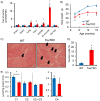Tissue depletion of taurine accelerates skeletal muscle senescence and leads to early death in mice
- PMID: 25229346
- PMCID: PMC4167997
- DOI: 10.1371/journal.pone.0107409
Tissue depletion of taurine accelerates skeletal muscle senescence and leads to early death in mice
Abstract
Taurine (2-aminoethanesulfonic acid) is found in milimolar concentrations in mammalian tissues. One of its main functions is osmoregulation; however, it also exhibits cytoprotective activity by diminishing injury caused by stress and disease. Taurine depletion is associated with several defects, many of which are found in the aging animal, suggesting that taurine might exert anti-aging actions. Therefore, in the present study, we examined the hypothesis that taurine depletion accelerates aging by reducing longevity and accelerating aging-associated tissue damage. Tissue taurine depletion in taurine transporter knockout (TauTKO) mouse was found to shorten lifespan and accelerate skeletal muscle histological and functional defects, including an increase in central nuclei containing myotubes, a reduction in mitochondrial complex 1 activity and an induction in an aging biomarker, Cyclin-dependent kinase 4 inhibitor A (p16INK4a). Tissue taurine depletion also enhances unfolded protein response (UPR), which may be associated with an improvement in protein folding by taurine. Our data reveal that tissue taurine depletion affects longevity and cellular senescence; an effect possibly linked to a disturbance in protein folding.
Conflict of interest statement
Figures




Similar articles
-
Beta-Catenin and SMAD3 Are Associated with Skeletal Muscle Aging in the Taurine Transpoeter Knockout Mouse.Adv Exp Med Biol. 2017;975 Pt 1:497-502. doi: 10.1007/978-94-024-1079-2_39. Adv Exp Med Biol. 2017. PMID: 28849477
-
Taurine depletion caused by knocking out the taurine transporter gene leads to cardiomyopathy with cardiac atrophy.J Mol Cell Cardiol. 2008 May;44(5):927-37. doi: 10.1016/j.yjmcc.2008.03.001. Epub 2008 Mar 18. J Mol Cell Cardiol. 2008. PMID: 18407290
-
Cardiac and skeletal muscle abnormality in taurine transporter-knockout mice.J Biomed Sci. 2010 Aug 24;17 Suppl 1(Suppl 1):S20. doi: 10.1186/1423-0127-17-S1-S20. J Biomed Sci. 2010. PMID: 20804595 Free PMC article. Review.
-
Induction of Growth Differentiation Factor 15 in Skeletal Muscle of Old Taurine Transporter Knockout Mouse.Biol Pharm Bull. 2018;41(3):435-439. doi: 10.1248/bpb.b17-00969. Biol Pharm Bull. 2018. PMID: 29491220
-
Potential Anti-aging Role of Taurine via Proper Protein Folding: A Study from Taurine Transporter Knockout Mouse.Adv Exp Med Biol. 2015;803:481-7. doi: 10.1007/978-3-319-15126-7_38. Adv Exp Med Biol. 2015. PMID: 25833520 Review. No abstract available.
Cited by
-
Taurine: the appeal of a safe amino acid for skeletal muscle disorders.J Transl Med. 2015 Jul 25;13:243. doi: 10.1186/s12967-015-0610-1. J Transl Med. 2015. PMID: 26208967 Free PMC article. Review.
-
Taurine: A Maternally Derived Nutrient Linking Mother and Offspring.Metabolites. 2022 Mar 5;12(3):228. doi: 10.3390/metabo12030228. Metabolites. 2022. PMID: 35323671 Free PMC article. Review.
-
Metabolomic profiling of plasma from middle-aged and advanced-age male mice reveals the metabolic abnormalities of carnitine biosynthesis in metallothionein gene knockout mice.Aging (Albany NY). 2021 Dec 1;13(23):24963-24988. doi: 10.18632/aging.203731. Epub 2021 Dec 1. Aging (Albany NY). 2021. PMID: 34851303 Free PMC article.
-
Expedition into Taurine Biology: Structural Insights and Therapeutic Perspective of Taurine in Neurodegenerative Diseases.Biomolecules. 2020 Jun 5;10(6):863. doi: 10.3390/biom10060863. Biomolecules. 2020. PMID: 32516961 Free PMC article. Review.
-
Identification and characterization of the Fasciola hepatica sodium- and chloride-dependent taurine transporter.PLoS Negl Trop Dis. 2018 Apr 27;12(4):e0006428. doi: 10.1371/journal.pntd.0006428. eCollection 2018 Apr. PLoS Negl Trop Dis. 2018. PMID: 29702654 Free PMC article.
References
-
- Eisenberg T, Knauer H, Schauer A, Buttner S, Ruckenstuhl C, et al. (2009) Induction of autophagy by spermidine promotes longevity. Nat Cell Biol 11: 1305–1314. - PubMed
Publication types
MeSH terms
Substances
Associated data
- Actions
LinkOut - more resources
Full Text Sources
Other Literature Sources
Medical
Molecular Biology Databases

